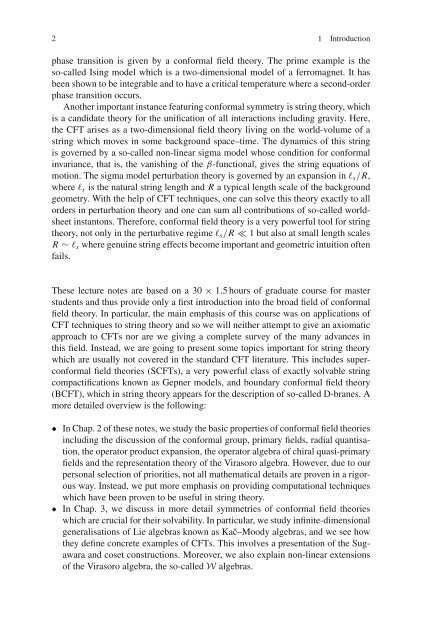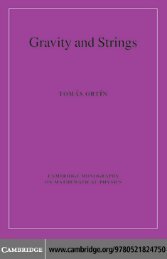Introduction to Conformal Field Theory: With Applications to String ...
Introduction to Conformal Field Theory: With Applications to String ...
Introduction to Conformal Field Theory: With Applications to String ...
Create successful ePaper yourself
Turn your PDF publications into a flip-book with our unique Google optimized e-Paper software.
2 1 <strong>Introduction</strong><br />
phase transition is given by a conformal field theory. The prime example is the<br />
so-called Ising model which is a two-dimensional model of a ferromagnet. It has<br />
been shown <strong>to</strong> be integrable and <strong>to</strong> have a critical temperature where a second-order<br />
phase transition occurs.<br />
Another important instance featuring conformal symmetry is string theory, which<br />
is a candidate theory for the unification of all interactions including gravity. Here,<br />
the CFT arises as a two-dimensional field theory living on the world-volume of a<br />
string which moves in some background space–time. The dynamics of this string<br />
is governed by a so-called non-linear sigma model whose condition for conformal<br />
invariance, that is, the vanishing of the β-functional, gives the string equations of<br />
motion. The sigma model perturbation theory is governed by an expansion in ℓs/R,<br />
where ℓs is the natural string length and R a typical length scale of the background<br />
geometry. <strong>With</strong> the help of CFT techniques, one can solve this theory exactly <strong>to</strong> all<br />
orders in perturbation theory and one can sum all contributions of so-called worldsheet<br />
instan<strong>to</strong>ns. Therefore, conformal field theory is a very powerful <strong>to</strong>ol for string<br />
theory, not only in the perturbative regime ℓs/R ≪ 1 but also at small length scales<br />
R ∼ ℓs where genuine string effects become important and geometric intuition often<br />
fails.<br />
These lecture notes are based on a 30 × 1.5 hours of graduate course for master<br />
students and thus provide only a first introduction in<strong>to</strong> the broad field of conformal<br />
field theory. In particular, the main emphasis of this course was on applications of<br />
CFT techniques <strong>to</strong> string theory and so we will neither attempt <strong>to</strong> give an axiomatic<br />
approach <strong>to</strong> CFTs nor are we giving a complete survey of the many advances in<br />
this field. Instead, we are going <strong>to</strong> present some <strong>to</strong>pics important for string theory<br />
which are usually not covered in the standard CFT literature. This includes superconformal<br />
field theories (SCFTs), a very powerful class of exactly solvable string<br />
compactifications known as Gepner models, and boundary conformal field theory<br />
(BCFT), which in string theory appears for the description of so-called D-branes. A<br />
more detailed overview is the following:<br />
• In Chap. 2 of these notes, we study the basic properties of conformal field theories<br />
including the discussion of the conformal group, primary fields, radial quantisation,<br />
the opera<strong>to</strong>r product expansion, the opera<strong>to</strong>r algebra of chiral quasi-primary<br />
fields and the representation theory of the Virasoro algebra. However, due <strong>to</strong> our<br />
personal selection of priorities, not all mathematical details are proven in a rigorous<br />
way. Instead, we put more emphasis on providing computational techniques<br />
which have been proven <strong>to</strong> be useful in string theory.<br />
• In Chap. 3, we discuss in more detail symmetries of conformal field theories<br />
which are crucial for their solvability. In particular, we study infinite-dimensional<br />
generalisations of Lie algebras known as Kač–Moody algebras, and we see how<br />
they define concrete examples of CFTs. This involves a presentation of the Sugawara<br />
and coset constructions. Moreover, we also explain non-linear extensions<br />
of the Virasoro algebra, the so-called W algebras.




